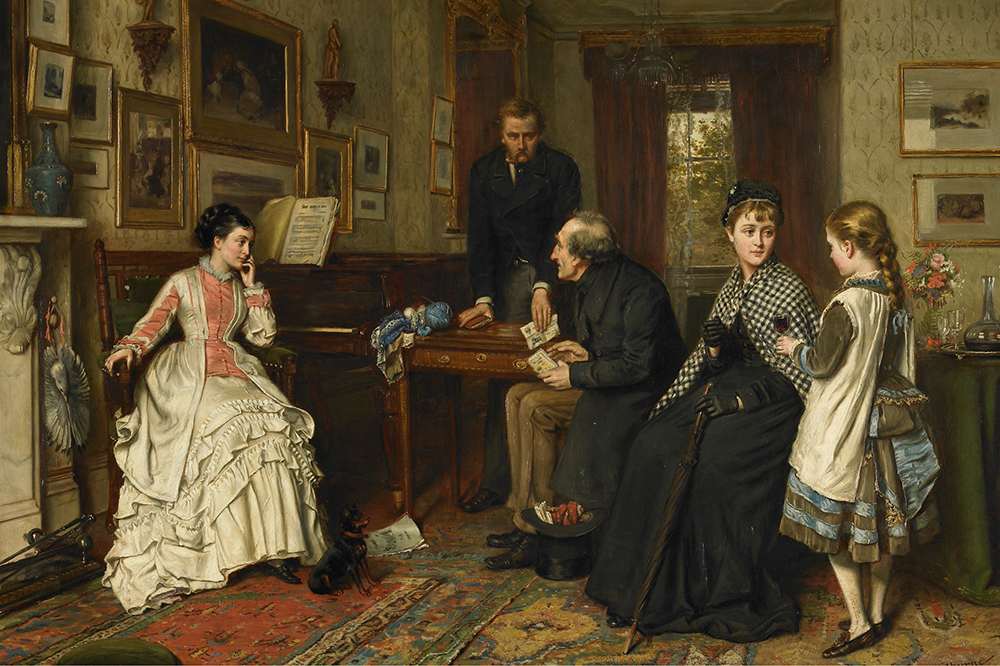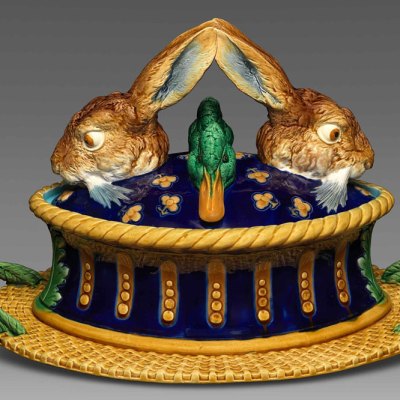From the December 2022 issue of Apollo. Preview and subscribe here.
‘Within a very few years, we are taken, as it were, by storm; we inundate ourselves with pictures… our abodes are becoming museums.’ By the time the Art Journal made this observation in 1847, it was well worn: Victorians seemed to be acquiring pictures on an unprecedented scale. This may have reflected the increasing dominance of painting as a medium (overtaking sculpture and fresco), but portability also made pictures a natural commodity. As a result, 19th-century homes were hung with everything from oils, watercolours and engravings to DIY efforts culled from illustrated newspapers and then framed. There were also plentiful examples of new technology: the photomechanical autotype, usually reproducing canonical oil paintings, vied with the bête noire of the art establishment, the mass-produced chromolithograph.
 As Nicholas Tromans points out in The Private Life of Pictures, which covers the period from 1800 to the outbreak of the Second World War, the 19th century was also a time of exhaustive discussion about how two-dimensional art should be displayed and consumed – at least, when out in public. Following the completion of the National Gallery building in the 1830s, John Ruskin envisaged the ideal museum as a single-storey toplit labyrinth with paintings hung alongside related drawings. However, despite the Art Journal’s comparison, 19th-century abodes were a world apart from museums, and Ruskin’s vision of earnest contemplation did not necessarily reflect how people engaged with pictures at home.
As Nicholas Tromans points out in The Private Life of Pictures, which covers the period from 1800 to the outbreak of the Second World War, the 19th century was also a time of exhaustive discussion about how two-dimensional art should be displayed and consumed – at least, when out in public. Following the completion of the National Gallery building in the 1830s, John Ruskin envisaged the ideal museum as a single-storey toplit labyrinth with paintings hung alongside related drawings. However, despite the Art Journal’s comparison, 19th-century abodes were a world apart from museums, and Ruskin’s vision of earnest contemplation did not necessarily reflect how people engaged with pictures at home.
There were some points of curatorial overlap, such as the widespread belief in the life-giving properties of sunlight: in 1869, Cassell’s Household Guide recommended that discoloured pictures be taken to a conservator to be ‘expose[d…] carefully to the sunshine, until the fading colours become revived’. However, many interior design manuals advised their readers to pursue more esoteric hanging solutions: using frames of twigs and branches, or installing creepers in bottles below pictures and training their tendrils behind the frames to create a ‘fairyland effect’, of which Ruskin would surely not have approved. Private owners were also unfettered by the rules governing visitors to national museums. In 1913, Jacques-Émile Blanche described how Edgar Degas, who was by then almost blind, recognised his favourite paintings by touch. ‘How many people kissed their pictures in private?’ Tromans asks. ‘Surely more than let on.’
Drawing on sources as various as Three Men in a Boat and Walter Benjamin, as well as household guides and trade magazines, The Private Lives of Pictures explores the challenges, assumptions and expectations brought to bear on the sudden influx of pictures on private walls. The subject is so rich that it is remarkable it has not been substantially discussed to date. One 19th-century antecedent is Leigh Hunt, whose much-reprinted essay ‘Put up a Picture in Your Room’ (1834) forms the focus of Tromans’ first section. For Hunt, domestic pictures facilitated ‘the going out of ourselves’. Even a faded reproduction pinned up with a few tacks offered a conduit to ‘the greatness and goodness of nature’. For others, they may have served less exalted purposes.
In a convivial tour through a representative, and predominantly middle-class, parlour, dining room, drawing room, bedroom and nursery (via many corridors and stairs), Tromans suggests that pictures served different functions in different places. In the dining room, traditionally considered a masculine space, portraits of ancestors and representations of animals and foodstuffs lived in the ‘dark background’ above the table, deferring to the food and company below. The occupants of the feminised drawing room, by contrast, were expected to flit around and study its contents; and so it was here that ‘the most was expected of pictures – decoratively and emotionally’.
Watercolours often provided an understated solution, while subjects such as mountains and fruit seemed to ‘welcome conversation on an equal footing’. Though – according to Henry Mayhew – street vendors considered children particularly susceptible to images of cats, many writers recommended that the nursery should abound with the fluffy dogs and golden-haired girls of Charles Burton Barber, alongside moralising images, the odd child portrait by Joshua Reynolds and Millais’s ubiquitous Bubbles (1886). All were hung well out of the reach, and therefore eyeline, of the children they sought to instruct.
Beyond the tacks, Leigh Hunt’s essay offers little in the way of practical picture-hanging advice, but here Tromans is gratifyingly exhaustive, covering the development of the picture rail (around 1800), popular views on lighting and wall colour (despite a professional preference for red or green, many domestic pictures had to vie with William Morris wallpapers), and the vexed question of whether to hang pictures flush or tilt them. While tilting offered a better experience of the picture, it risked the sensation of what one writer characterised as ‘living under tottering crags’. It also threatened to give artworks undue prominence within the interior, increasingly conceived as an aesthetic presence in its own right, within which pictures might be uneasy aliens. By the 1920s, Le Corbusier was complaining that they interfered with his clean architectural lines and hoped to remove them altogether.
Indeed, while there may have been a theoretically ‘ideal’ positioning for many pictures, once inside the house, few seem to have stayed still. Instead, they moved from room to room, and into corridors, staircases and attics as their status or significance evolved, and as they proved more or less resistant to their owners’ ambitions. Tromans recounts the anxieties that drove Dante Gabriel Rossetti’s Mariana from William Graham’s dining room to his drawing room, and at last off the wall and on to an easel (‘a kind of prestigious naughty-step’). While the home provided pictures, and particularly portraits, with crucial context and identity, The Private Lives of Pictures suggests this relationship could often be fractious. In the process, it offers a provocative new approach to the history of art and interiors.
The Private Life of Pictures: Art at Home in Britain, 1800–1940 by Nicholas Tromans is published by Reaktion Books.
From the December 2022 issue of Apollo. Preview and subscribe here.



